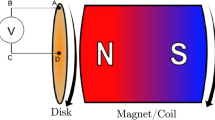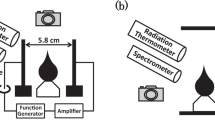Abstract
WHILE carrying on some experiments with the electric arc between iron electrodes, one of my students, Mr. H. D. Arnold, noticed that there was a certain critical P.D. at which an abrupt change took place in the conditions of the arc. Subsequent investigation has shown that the effect is closely analogous to the “hissing point” of the carbon arc. How close the analogy is may be seen from the following remarks. If the iron arc is started with a large external resistance and maintained at such a length that the current is well below one ampere, it burns with little or no sound, and its appearance in the neighbourhood of the anode is very diffuse and ill-defined. As the external resistance is gradually decreased, the PD. falls and the current rises until a certain critical value, depending on the length of arc and size of electrodes, is reached. At this point a very small decrease in external resistance suffices to cause a sudden increase in current and drop in P.D., precisely as with the carbon arc. At the same time the arc contracts, a bright spot appears on the anode, and a characteristic hissing sound begins. Further increase of current is accompanied by a continued decrease in P.D. The hissing stage, in fact, begins at quite a different point on the P.D.-current diagram from that in the case of the carbon arc. If the experiment is carried out in the reverse order, starting with a large current, the discontinuity is encountered again, but not until the current has been diminished beyond the value that it had at the beginning of the hissing stage. Indeed, with arcs of 6 mm. and more, the current on the hissing stage can with care be decreased until it is smaller than its previous largest value on the quiet stage. Thus there are two possible values of P.D. for the same current and length of arc, one corresponding to the quiet, the other to the hissing stage.
This is a preview of subscription content, access via your institution
Access options
Subscribe to this journal
Receive 51 print issues and online access
$199.00 per year
only $3.90 per issue
Buy this article
- Purchase on Springer Link
- Instant access to full article PDF
Prices may be subject to local taxes which are calculated during checkout
Similar content being viewed by others
Author information
Authors and Affiliations
Rights and permissions
About this article
Cite this article
CADY, W. The Iron Arc. Nature 74, 443–444 (1906). https://doi.org/10.1038/074443c0
Issue Date:
DOI: https://doi.org/10.1038/074443c0
Comments
By submitting a comment you agree to abide by our Terms and Community Guidelines. If you find something abusive or that does not comply with our terms or guidelines please flag it as inappropriate.



